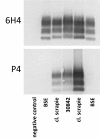Surveillance and simulation of bovine spongiform encephalopathy and scrapie in small ruminants in Switzerland
- PMID: 20398417
- PMCID: PMC2867968
- DOI: 10.1186/1746-6148-6-20
Surveillance and simulation of bovine spongiform encephalopathy and scrapie in small ruminants in Switzerland
Abstract
Background: After bovine spongiform encephalopathy (BSE) emerged in European cattle livestock in 1986 a fundamental question was whether the agent established also in the small ruminants' population. In Switzerland transmissible spongiform encephalopathies (TSEs) in small ruminants have been monitored since 1990. While in the most recent TSE cases a BSE infection could be excluded, for historical cases techniques to discriminate scrapie from BSE had not been available at the time of diagnosis and thus their status remained unclear. We herein applied state-of-the-art techniques to retrospectively classify these animals and to re-analyze the affected flocks for secondary cases. These results were the basis for models, simulating the course of TSEs over a period of 70 years. The aim was to come to a statistically based overall assessment of the TSE situation in the domestic small ruminant population in Switzerland.
Results: In sum 16 TSE cases were identified in small ruminants in Switzerland since 1981, of which eight were atypical and six were classical scrapie. In two animals retrospective analysis did not allow any further classification due to the lack of appropriate tissue samples. We found no evidence for an infection with the BSE agent in the cases under investigation. In none of the affected flocks, secondary cases were identified. A Bayesian prevalence calculation resulted in most likely estimates of one case of BSE, five cases of classical scrapie and 21 cases of atypical scrapie per 100'000 small ruminants. According to our models none of the TSEs is considered to cause a broader epidemic in Switzerland. In a closed population, they are rather expected to fade out in the next decades or, in case of a sporadic origin, may remain at a very low level.
Conclusions: In summary, these data indicate that despite a significant epidemic of BSE in cattle, there is no evidence that BSE established in the small ruminant population in Switzerland. Classical and atypical scrapie both occur at a very low level and are not expected to escalate into an epidemic. In this situation the extent of TSE surveillance in small ruminants requires reevaluation based on cost-benefit analysis.
Figures



Similar articles
-
European Union's rapid TSE testing in adult cattle and sheep: implementation and results in 2001 and 2002.Stat Methods Med Res. 2003 Jun;12(3):261-78. doi: 10.1191/0962280203sm331ra. Stat Methods Med Res. 2003. PMID: 12828246
-
Strain typing of German transmissible spongiform encephalopathies field cases in small ruminants by biochemical methods.J Vet Med B Infect Dis Vet Public Health. 2005 Mar;52(2):55-63. doi: 10.1111/j.1439-0450.2005.00827.x. J Vet Med B Infect Dis Vet Public Health. 2005. PMID: 15752263
-
TSE eradication in small ruminants--quo vadis?Berl Munch Tierarztl Wochenschr. 2005 Sep-Oct;118(9-10):365-71. Berl Munch Tierarztl Wochenschr. 2005. PMID: 16206923 Review.
-
Clinical, pathological, and molecular features of classical and L-type atypical-BSE in goats.PLoS One. 2018 May 24;13(5):e0198037. doi: 10.1371/journal.pone.0198037. eCollection 2018. PLoS One. 2018. PMID: 29795663 Free PMC article.
-
Risk management of transmissible spongiform encephalopathies in Europe.Rev Sci Tech. 2003 Apr;22(1):179-99. doi: 10.20506/rst.22.1.1392. Rev Sci Tech. 2003. PMID: 12793779 Review.
Cited by
-
Distinct proteinase K-resistant prion protein fragment in goats with no signs of disease in a classical scrapie outbreak.J Clin Microbiol. 2011 Jun;49(6):2109-15. doi: 10.1128/JCM.02033-10. Epub 2011 Mar 30. J Clin Microbiol. 2011. PMID: 21450953 Free PMC article.
-
Trends in genotype frequency resulting from breeding for resistance to classical scrapie in Belgium (2006 ˜ 2011).J Vet Sci. 2013;14(1):45-51. doi: 10.4142/jvs.2013.14.1.45. Epub 2013 Feb 5. J Vet Sci. 2013. PMID: 23388443 Free PMC article.
References
-
- Hörnlimann B, Riesner D, Kretzschmar H. Prions in Humans and Animals. Berlin: De Gruyter; 2007.
-
- Gavier-Widen D, Stack MJ, Baron T, Balachandran A, Simmons M. Diagnosis of transmissible spongiform encephalopathies in animals: a review. J Vet Diagn Invest. 2005;17:509–527. - PubMed
-
- McGowan JP. Scrapie in sheep. Scottish J Agric. 1922;5:365–375.
-
- Parry HB. Scrapie disease in sheep. London: Academic Press; 1983.
Publication types
MeSH terms
LinkOut - more resources
Full Text Sources

